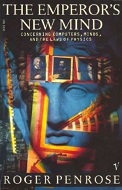Review of 'The Emperor's New Mind'
The Emperor's New Mind by Roger Penrose
 This book has been sitting on my “to read” shelf for more years than I care to admit daunting in it's 581 pages (excluding references and index) I have been put off by knowing that it would be a significant effort to read. I was correct. It has taken me more than two months to read, taking much longer than I would normally take to finish as I have had to read extremely carefully. Yes, this is a dense book full of amazing insights and I would like to think I have actually learned something along the way. Alternatively, I have been so confused I block this whole exercise out of my mind never to recall again.
This book has been sitting on my “to read” shelf for more years than I care to admit daunting in it's 581 pages (excluding references and index) I have been put off by knowing that it would be a significant effort to read. I was correct. It has taken me more than two months to read, taking much longer than I would normally take to finish as I have had to read extremely carefully. Yes, this is a dense book full of amazing insights and I would like to think I have actually learned something along the way. Alternatively, I have been so confused I block this whole exercise out of my mind never to recall again.
“The Emperor's New Mind” (subtitle “Concerning Computers, Minds, and the Laws of Physics”) is a reference to the story of the emperor's new clothes where the erstwhile emperor parades around the street of his kingdom stark naked having been convinced by a charlatan that he has been given the finest of clothes only visible by those sophisticated enough to do so. In this case the clothes are the mind and the “new clothes” the promises of exponents of “strong AI” who contend that truly artificial intelligence is possible by purely computational means given enough computational resources. Penrose believes firmly that this is not possible and uses the bulk of the book to provide background to his theory put forth in the final chapters. This background consists of chapters covering everything from “Turing Machines” (the definition of computation) to Quantum physics and the physiology of the brain. As you may expect, this material is quite heavy in nature (though Penrose makes great pains to ease the reader into it) but I was lucky enough to have some familiarity with it but still a number of sections took me a very long time to take in particularly when Penrose (a mathematician) starts diving into mathematics of which I have very little exposure. To be fair, from the outset Penrose makes it clear he will be doing this and suggests that those that do not wish to take in the formulas can proceed though cautions that this is not such a wise idea, which I completely agree with. I have to say I had to read this understanding that I would not be able to completely comprehend it all but resolved to understand the meaning of what he was saying, which, of course, is more important: The implications of his ruminations and the information he conveys in each chapter. To this end I skipped many of the footnotes to avoid distractions along the way. This, I feel, is what most readers of this book will have to do and did mean that I was able to honestly understand his final theory though with it's slight amount of hand-waving is not entirely satisfying to this reader though it is also clear that many of the theories on which modern thinking is based involves similar amounts of hand-waving.
In recent years with the advent of the first quantum computers, quantum teleportation, and better understanding of the rules underlying the nature of our universe it is doubtless some of the content here is now outdated but I suspect the general conclusions and thinking is not. These days often the notion of “AI” is confused with the massive “pattern matching” exercise most technologies use. Here we explore the true idea of artificial intelligence: An truly thinking machine. Whether this will ever be possible remains to be seen but Penrose here shines significant doubt into whether this will ever be possible.
Rating: “Really good but I have some issues”
Review Date: 2018-10-07
Genre: Non-Fiction
Publisher: Vintage
Publication Date: 1989
ISBN: 0099771705